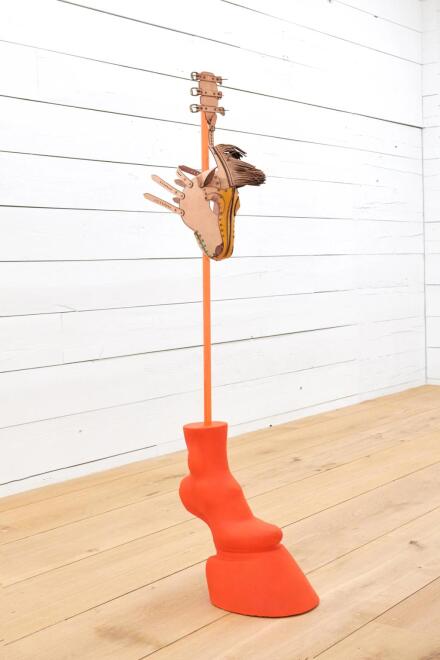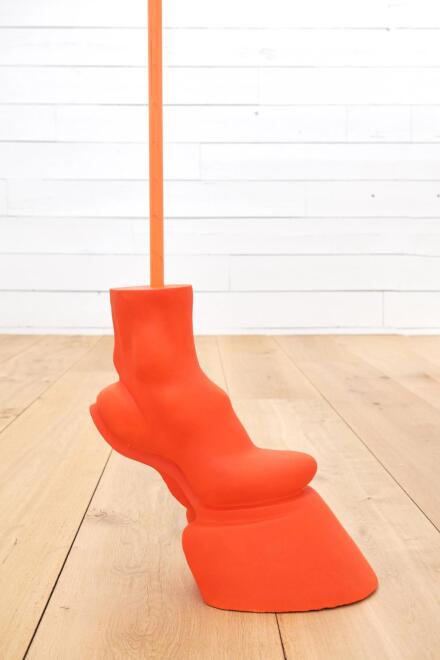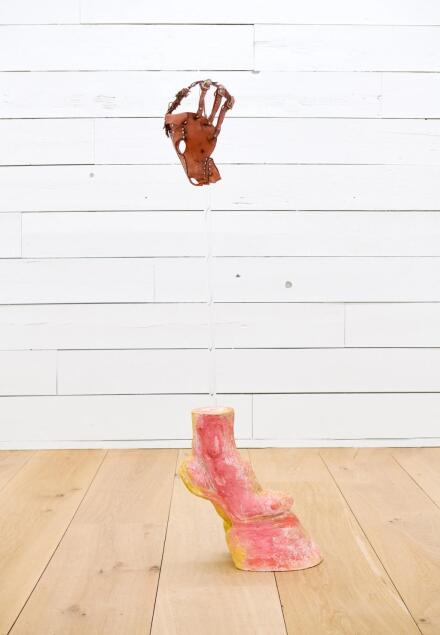
Lena Henke, Memory of young sculpture VIII (2023), all images via The Ranch
This summer at The Ranch in Montauk, artist Lena Henke has installed a body of works that respond to the site’s equestrian and architectural histories. Titled Nature Wills It, the exhibition brings together a range of works that combine human and animal signifiers to create a range of formally and conceptually-challenging works in the gallery space. Rather than put forward a coherent and unified body, Henke’s work proposes alternate ways of figuring the horse. These sculptures evince an agonistic making: grappling for different means of picturing the animal’s visual features. Endeavoring toward the haptic and latent, the horse is segmented into components (head, body, hoof), each given its own handling and media.

Lena Henke, Memory of young sculpture VIII (detail) (2023)
Throughout, Henke’s work draws on the horse as both present and absent, ghost and figure, foreground and background. Trodden, handmade leather masks serve as each horse’s visage, while transparent plastic rods lend a concise shorthand for the body. A startling reduction of form, Henke trims the sinuous limbs and protruding haunch with readymade plastic, instructing her viewers to imagine the body as a vehicle for calling forth repressed memories or forgotten encounters. Resisting sculptural stolidity, the hoof meets the ground, ready for ambulation, while the pole quietly begs to be ridden like a child’s hobby horse.
The artist presents a body in transformation, twisting and swirling around both human and animal structures. The leather heads of each horse are modeled after fetish masks––playing with the fetish as a possible escape route. The artist’s tumble into leatherwork and underground ritual is approached with rigor––extensive research and experimentation undergirds the techniques applied to the masks. First hand-stitched, these masks are then boiled––transforming the supple material into hardened structures, and then shaped by packing them with miscellaneous items from the artist’s studio. In effect, these horses appear ridden, recuperating from battle, or at the very least worn out after a long day. Yet there’s equal notions of tenderness and sensitivity on view, the structure if the body implying the care and custody of the stable, as if the works were trotted out by the artist from her own personal coterie of horses. The activity of caretaking emphasizes the quasi-romantic, even dormant sexualization, of the bond between horse and owner. Henke makes this more overtly understood in a suite of wall-bound reliefs, Combustions, presented in the exterior galleries. Creating “portraits” of the horse mask sculptures, these suspend the horse heads within a coterie of intervening hands that caress and grope. Though mounted to the wall, Henke clarifies that these too are sculptural in scope––emphasizing their objecthood by wrapping the support in leather, which is later scored, burned, and dyed.

Lena Henke, Memory of young sculpture I (2023)
Throughout Henke’s practice, the horse emerges as a device through which the artist probes matters personal, psychosexual, and sensorial. Sharing the title Memory of young sculpture, the work presented in the “gallery barn” engages a self-reflexive mode, figuratively exhausting the motif of the horse. The equine grazes against subterranean subcultures of sexual play and domination, while intersecting with Henke’s longstanding interrogation of urban spaces and the psychogeography of cities: the Meatpacking District, a reserve of inspiration for this new body of work, housed butchers and fetish clubs alike in the 1980s. Henke makes visible these seemingly oppositional concurrences through a logic of material interplay, allowing the irrational to demonstrate its own capacity for coherence.
The show closes June 14th.
– D. Creahan
Read more:
The Ranch [Exhibition Site]



